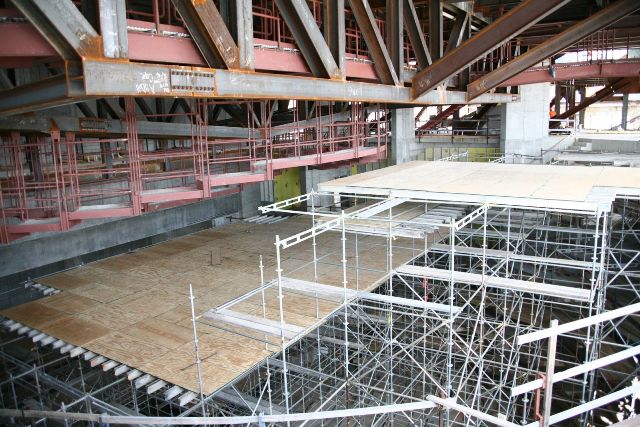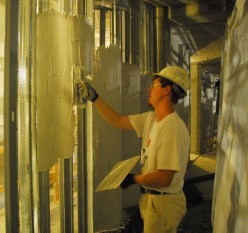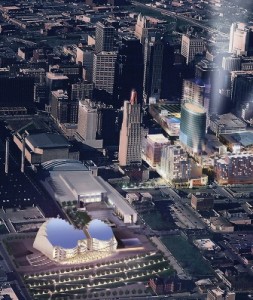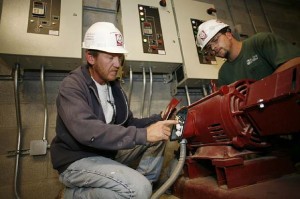01
Local Firms Bring Their Artistry to Bear on the Kauffman Center

Inside the Kauffman Center, a steady stream of activity is taking place. With both performance spaces now closed off from the elements, workers can be found in almost every nook and cranny, welding, plastering, fireproofing, installing plumbing, drywall and electrical systems — just to mention a few.
These workers come from dozens of local firms that are contributing their particular expertise and artistry to this stage of the building process. Here are just a few examples of the activities taking place, and the jobs being generated, at our community’s biggest construction project.
Patent Construction Systems has been working on local construction sites for more than 45 years. Ten of their staff spent nearly two months erecting scaffolding inside both halls at the Kauffman Center. While their Quick Erect System won’t be a permanent part of the performing arts center, it plays a vital role in the building process.
Internal finishing work requires access to the highest points of the two halls, for components such as fireproofing, electrical work, ceiling installation and finish to the walls and balconies. “This requires scaffolding to support work being done as high as 70 feet,” explains Kyle McQuiston, JE Dunn Construction project manager. In the photo above the scaffolding is being completed in the proscenium theatre.
As work is finished at the highest points, interior levels of scaffolding, no longer needed for the ceiling, will be removed, while the outer perimeter will remain in place to complete walls.
 “Nothing makes us happier than to have the opportunity to allow our talented craftsmen to showcase their ability, attention to detail and outstanding quality,” says Shawn Burnum, PCI branch manager. Plasterers from PCI Dahmer are hard at work on interior finish work. Cement plastering is taking place in the ceilings, and thinner, “veneer plaster” is going into public spaces, such as lobby and hall areas.
“Nothing makes us happier than to have the opportunity to allow our talented craftsmen to showcase their ability, attention to detail and outstanding quality,” says Shawn Burnum, PCI branch manager. Plasterers from PCI Dahmer are hard at work on interior finish work. Cement plastering is taking place in the ceilings, and thinner, “veneer plaster” is going into public spaces, such as lobby and hall areas.
In the photo at right, plasterer Abel Baldwin is “scratch-coating” acoustical “bumps” in the concert hall. This first step in the plastering process prepares these unusual half moon shapes to make an important contribution to the quality of sound. Plaster must be pumped up several stories from a cement mixer below and suctioned through a tube to reach the workers.
“The ceilings in the two halls are works of art in themselves,” says Burnum. “They play an important role in deflecting sound, plus they must be safe and beautiful.” That’s a tall order for a plaster ceiling that weighs 25 pounds per square foot and is suspended high above the audience and performers.
PCI has up to 20 people at work on any particular day, doing metal stud framing, drywall insulation and fire stopping, in addition to the plaster work.

Making Powerful Connections
A 25-30 member Mark One crew is currently working at the Kauffman Center site, tackling a number of projects including:
- Five major substations
- Theatrical dimming systems
- Back-up emergency generator
- Architectural lighting
- Security system
- Telephone and data infrastructure
A year from now, this list of electrical projects will become even longer, as the exterior shell is put in place and things like sound and audio visual systems, installation of the Figaro seat-back title system, theatrical lighting and illuminating the exterior shell itself become possible. Mark One Electric is a family-owned WBE business with a long list of projects to their credit, including the JE Dunn World Headquarters, Kauffman and Chief’s stadiums, the Federal Reserve Bank and the new IRS Center.

Mark One crew members check phasing for motor wiring.